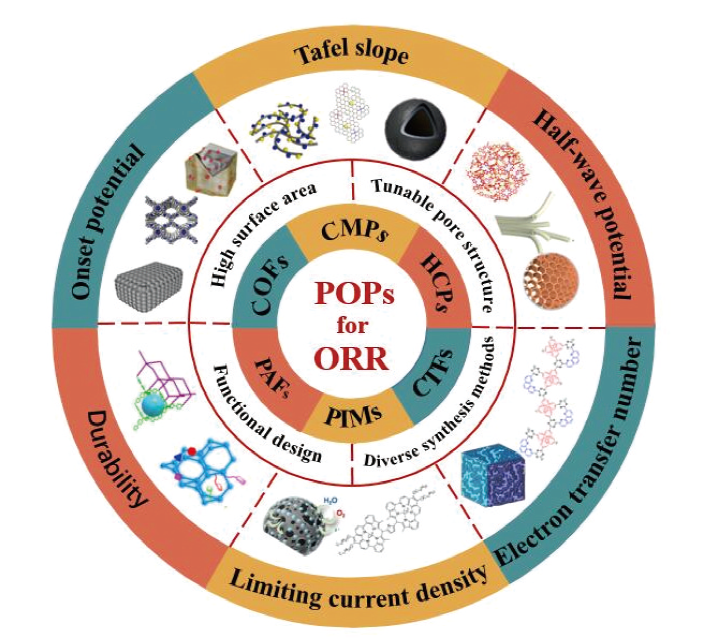 PDF(5359 KB)
PDF(5359 KB)


Carbon-Based Electrocatalyst Derived from Porous Organic Polymer in Oxygen Reduction Reaction for Fuel Cells
Sun Hanxue, Wang Juanjuan, Zhu Zhaoqi, Li An
Prog Chem ›› 2023, Vol. 35 ›› Issue (11) : 1638-1654.
 PDF(5359 KB)
PDF(5359 KB)
 PDF(5359 KB)
PDF(5359 KB)
Carbon-Based Electrocatalyst Derived from Porous Organic Polymer in Oxygen Reduction Reaction for Fuel Cells
Fuel cell, a kind of energy conversion device that can directly convert chemical energy into electric energy, is a new and an important energy technology during China’s 14th Five-Year Plan. In recent years, the fuel cell technology has undergone iterative upgrading, which effectively promotes the transition of hydrogen energy industry from mode-exploration to multiple demonstration, and helps the high-quality development of the new energy. Cathodic oxygen reduction reaction (ORR) is one of the basic and core reactions of fuel cells, but its slow kinetic process restricts the large-scale application of fuel cells. Although metal Pt-based catalysts have high catalytic activity and can improve the reaction rate of ORR, they are not conducive to wide commercial use because of their scarcity, high cost and poor durability. The development of non-Pt-based ORR catalysts is of great practical significance to promote the development of fuel cells. Porous Organic Polymers (POPs) are an important branch of porous materials. Due to their controllable composition and diverse structure, heteroatoms and metal species can be incorporated into the skeleton to enhance the overall catalytic activity of materials. As ideal candidate materials for electrocatalysts with high-efficiency, POPs have attracted wide attention in promoting the slow kinetics of ORR. In this paper, the research progress in the synthesis strategy, composition, morphology, structure regulation and electrocatalytic performance of POPs-derived carbon-based ORR electrocatalysts in recent years are emphatically introduced. The challenges faced by POPs-derived carbon-based ORR electrocatalysts at present are discussed, and their future development directions are summarized.
1 Introduction
2 Oxygen reduction reaction(ORR)mechanism
3 Design and performance of porous organic polymer derived carbon-based ORR electrocatalysts
3.1 Conjugated microporous polymers(CMPs)derived carbon-based ORR catalysts
3.2 Covalent organic frameworks(COFs)derived carbon-based ORR catalysts
3.3 Hyper-cross-linked polymers(HCPs)derived carbon-based ORR catalysts
3.4 Covalent triazine frameworks(CTFs)derived carbon-based ORR catalysts
3.5 Polymers of intrinsic microporosity(PIMs)derived carbon-based ORR catalysts
3.6 Porous aromatic frameworks(PAFs)derived carbon-based ORR catalysts
4 Conclusion and outlook

cathodic oxygen reduction / porous organic polymer / conjugated microporous polymers / structural tunability / fuel cell
| [1] |
|
| [2] |
|
| [3] |
|
| [4] |
|
| [5] |
|
| [6] |
|
| [7] |
|
| [8] |
|
| [9] |
|
| [10] |
|
| [11] |
|
| [12] |
|
| [13] |
|
| [14] |
|
| [15] |
|
| [16] |
|
| [17] |
|
| [18] |
|
| [19] |
|
| [20] |
|
| [21] |
|
| [22] |
|
| [23] |
|
| [24] |
|
| [25] |
|
| [26] |
|
| [27] |
|
| [28] |
|
| [29] |
|
| [30] |
|
| [31] |
|
| [32] |
|
| [33] |
|
| [34] |
|
| [35] |
|
| [36] |
|
| [37] |
|
| [38] |
|
| [39] |
|
| [40] |
|
| [41] |
|
| [42] |
|
| [43] |
|
| [44] |
|
| [45] |
|
| [46] |
|
| [47] |
|
| [48] |
|
| [49] |
|
| [50] |
|
| [51] |
|
| [52] |
|
| [53] |
|
| [54] |
|
| [55] |
|
| [56] |
|
| [57] |
|
| [58] |
|
| [59] |
|
| [60] |
|
| [61] |
|
| [62] |
|
| [63] |
|
| [64] |
|
| [65] |
|
| [66] |
|
| [67] |
|
| [68] |
|
| [69] |
|
| [70] |
|
| [71] |
|
| [72] |
|
| [73] |
|
| [74] |
|
| [75] |
|
| [76] |
|
| [77] |
|
| [78] |
|
| [79] |
|
| [80] |
|
| [81] |
|
| [82] |
|
| [83] |
|
| [84] |
|
| [85] |
|
| [86] |
|
| [87] |
|
| [88] |
|
| [89] |
|
| [90] |
|
| [91] |
|
| [92] |
|
| [93] |
|
| [94] |
|
| [95] |
|
| [96] |
|
| [97] |
|
| [98] |
|
| [99] |
|
| [100] |
|
| [101] |
|
| [102] |
|
| [103] |
|
| [104] |
|
| [105] |
|
| [106] |
|
| [107] |
|
| [108] |
|
/
| 〈 |
|
〉 |